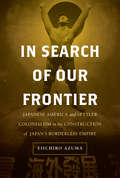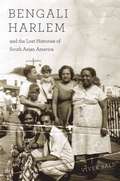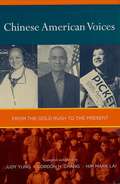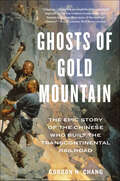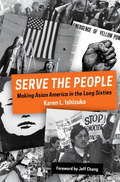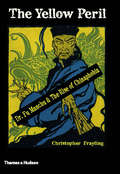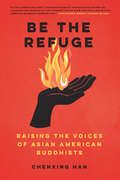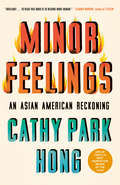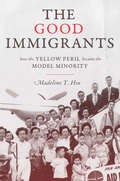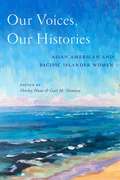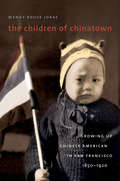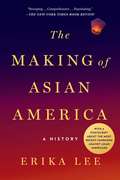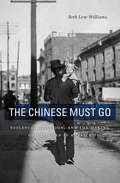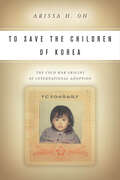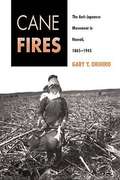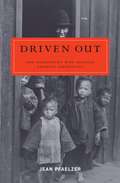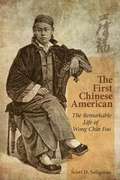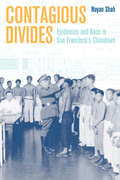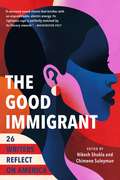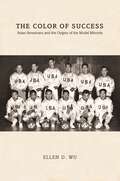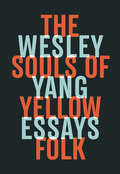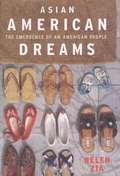Special Collections
History Of Anti-Asian Sentiment In The U.S
Description: This collection contains titles that help readers better understand the history of anti-Asian and Pacific Islander discrimination in the United States. #adults #nonfiction
- Table View
- List View
In Search of Our Frontier
by Eiichiro AzumaIn Search of Our Frontier explores the complex transnational history of Japanese immigrant settler colonialism, which linked Japanese America with Japan’s colonial empire through the exchange of migrant bodies, expansionist ideas, colonial expertise, and capital in the Asia-Pacific basin before World War II.
The trajectories of Japanese transpacific migrants exemplified a prevalent national structure of thought and practice that not only functioned to shore up the backbone of Japan’s empire building but also promoted the borderless quest for Japanese overseas development. Eiichiro Azuma offers new interpretive perspectives that will allow readers to understand Japanese settler colonialism’s capacity to operate outside the aegis of the home empire.
Bengali Harlem and the Lost Histories of South Asian America
by Vivek BaldIn the final years of the nineteenth century, small groups of Muslim peddlers arrived at Ellis Island every summer, bags heavy with embroidered silks from their home villages in Bengal. The American demand for Oriental goods took these migrants on a curious path, from New Jersey’s beach boardwalks into the heart of the segregated South.
Two decades later, hundreds of Indian Muslim seamen began jumping ship in New York and Baltimore, escaping the engine rooms of British steamers to find less brutal work onshore. As factory owners sought their labor and anti-Asian immigration laws closed in around them, these men built clandestine networks that stretched from the northeastern waterfront across the industrial Midwest. The stories of these early working-class migrants vividly contrast with our typical understanding of immigration.
Vivek Bald’s meticulous reconstruction reveals a lost history of South Asian sojourning and life-making in the United States. At a time when Asian immigrants were vilified and criminalized, Bengali Muslims quietly became part of some of America’s most iconic neighborhoods of color, from Tremé in New Orleans to Detroit’s Black Bottom, from West Baltimore to Harlem. Many started families with Creole, Puerto Rican, and African American women. As steel and auto workers in the Midwest, as traders in the South, and as halal hot dog vendors on 125th Street, these immigrants created lives as remarkable as they are unknown. Their stories of ingenuity and intermixture challenge assumptions about assimilation and reveal cross-racial affinities beneath the surface of early twentieth-century America.
Chinese American Voices
by Judy Yung and Gordon H. Chang and Him Mark LaiDescribed by others as quaint and exotic, or as depraved and threatening, and, more recently, as successful and exemplary, the Chinese in America have rarely been asked to describe themselves in their own words.
This superb anthology, a diverse and illuminating collection of primary documents and stories by Chinese Americans, provides an intimate and textured history of the Chinese in America from their arrival during the California Gold Rush to the present. Among the documents are letters, speeches, testimonies, oral histories, personal memoirs, poems, essays, and folksongs; many have never been published before or have been translated into English for the first time. They bring to life the diverse voices of immigrants and American-born; laborers, merchants, and professionals; ministers and students; housewives and prostitutes; and community leaders and activists. Together, they provide insight into immigration, work, family and social life, and the longstanding fight for equality and inclusion. Featuring photographs and extensive introductions to the documents written by three leading Chinese American scholars, this compelling volume offers a panoramic perspective on the Chinese American experience and opens new vistas on American social, cultural, and political history.
Ghosts Of Gold Mountain
by Gordon H. Chang&“Gripping . . . Chang has accomplished the seemingly impossible . . . He has written a remarkably rich, human, and compelling story of the railroad Chinese.&” — Peter Cozzens, Wall Street JournalWINNER OF THE ASIAN/PACIFIC AMERICAN AWARD FOR LITERATURE WINNER OF THE CHINESE AMERICAN LIBRARIANS ASSOCIATION BEST BOOK AWARDA groundbreaking, breathtaking history of the Chinese workers who built the Transcontinental Railroad, helping to forge modern America only to disappear into the shadows of history until now From across the sea, they came by the thousands, escaping war and poverty in southern China to seek their fortunes in America. Converging on the enormous western worksite of the Transcontinental Railroad, the migrants spent years dynamiting tunnels through the snow-packed cliffs of the Sierra Nevada and laying tracks across the burning Utah desert. Their sweat and blood fueled the ascent of an interlinked, industrial United States. But those of them who survived this perilous effort would suffer a different kind of death: a historical one, as they were pushed first to the margins of American life and then to the fringes of public memory. In this groundbreaking account, award-winning scholar Gordon H. Chang draws on unprecedented research to recover the Chinese railroad workers&’ stories and celebrate their role in remaking America. An invaluable correction of a great historical injustice, The Ghosts of Gold Mountain returns these &“silent spikes&” to their rightful place in our national saga.&“The lived experience of the Railroad Chinese has long been elusive . . . Chang&’s book is a moving effort to recover their stories and honor their indispensable contribution to the building of modern America.&” — New York Times
Serve the People
by Jeff Chang and Karen IshizukaA narrative history of the movement that turned "Orientals" into Asian Americans Until the political ferment of the Long Sixties, there were no Asian Americans. There were only isolated communities of mostly Chinese, Japanese, and Filipinos lumped together as "Orientals."
Serve the People tells the story of the social and cultural movement that knit these disparate communities into a political identity, the history of how--and why--the double consciousness of Asian America came to be. At the same time, Karen Ishizuka's vivid narrative reveals the personal epiphanies and intimate stories of insurgent movers and shakers and ground-level activists alike.
Drawing on more than 120 interviews and illustrated with striking images from guerrilla movement publications, the book evokes the feeling of growing up alien in a society rendered in black and white, and recalls the intricate memories and meanings of the Asian American movement. Serve the People paints a panoramic landscape of a radical time, and is destined to become the definitive history of the making of Asian America.
The Yellow Peril
by Christopher FraylingAn entirely new perspective on current scaremongering about China's global ambitions, and on the Western media's ignorance of Chinese culture
A hundred years ago, a character who was to enter the bloodstream of 20th-century popular culture made his first appearance in the world of literature. In his day he became as well known as Count Dracula or Sherlock Holmes: he was the evil genius called Dr. Fu Manchu, described at the beginning of the first story in which he appeared as "the yellow peril incarnate in one man."
Why did the idea that the Chinese were a threat to Western civilization develop at precisely the time when China was in chaos, divided against itself, the victim of successive famines and utterly incapable of being a "peril" to anyone even if it had wanted to be? Even the author of the Dr. Fu Manchu novels, Sax Rohmer, acknowledged that China, "as a nation possess that elusive thing, poise."
And what do the Chinese themselves make of all this? Is it any wonder that they remember what we have carelessly forgotten-the opium wars; the "unfair treaties" that ceded Hong Kong and the New Territories; and the stereotyping of Chinese people in allegedly factual studies?
Here cultural historian Christopher Frayling takes us to the heart of popular culture in the music hall, pulp literature, and the mass-market press, and shows how film amplifies our assumptions.
Be the Refuge
by Chenxing HanA must-read for modern sanghas--Asian American Buddhists in their own words, on their own terms. Despite the fact that two thirds of U.S. Buddhists identify as Asian American, mainstream perceptions about what it means to be Buddhist in America often whitewash and invisibilize the diverse, inclusive, and intersectional communities that lie at the heart of American Buddhism. Be the Refuge is both critique and celebration, calling out the erasure of Asian American Buddhists while uplifting the complexity and nuance of their authentic stories and vital, thriving communities. Drawn from in-depth interviews with a pan-ethnic, pan-Buddhist group, Be the Refuge is the first book to center young Asian American Buddhists' own voices. With insights from multi-generational, second-generation, convert, and socially engaged Asian American Buddhists, Be the Refuge includes the stories of trailblazers, bridge-builders, integrators, and refuge-makers who hail from a wide range of cultural and religious backgrounds.
Championing nuanced representation over stale stereotypes, Han and the 89 interviewees in Be the Refuge push back against false narratives like the Oriental monk, the superstitious immigrant, and the banana Buddhist--typecasting that collapses the multivocality of Asian American Buddhists into tired, essentialized tropes. Encouraging frank conversations about race, representation, and inclusivity among Buddhists of all backgrounds, Be the Refuge embodies the spirit of interconnection that glows at the heart of American Buddhism.
Minor Feelings
by Cathy Park HongPoet and essayist Cathy Park Hong fearlessly and provocatively blends memoir, cultural criticism, and history to expose fresh truths about racialized consciousness in America. Part memoir and part cultural criticism, this collection is vulnerable, humorous, and provocative—and its relentless and riveting pursuit of vital questions around family and friendship, art and politics, identity and individuality, will change the way you think about our world. Binding these essays together is Hong’s theory of “minor feelings.”
As the daughter of Korean immigrants, Cathy Park Hong grew up steeped in shame, suspicion, and melancholy. She would later understand that these “minor feelings” occur when American optimism contradicts your own reality—when you believe the lies you’re told about your own racial identity. Minor feelings are not small, they’re dissonant—and in their tension Hong finds the key to the questions that haunt her. With sly humor and a poet’s searching mind, Hong uses her own story as a portal into a deeper examination of racial consciousness in America today. This intimate and devastating book traces her relationship to the English language, to shame and depression, to poetry and female friendship. A radically honest work of art, Minor Feelings forms a portrait of one Asian American psyche—and of a writer’s search to both uncover and speak the truth.
The Good Immigrants
by Madeline Y. HsuConventionally, US immigration history has been understood through the lens of restriction and those who have been barred from getting in. In contrast, The Good Immigrants considers immigration from the perspective of Chinese elites--intellectuals, businessmen, and students--who gained entrance because of immigration exemptions.
Exploring a century of Chinese migrations, Madeline Hsu looks at how the model minority characteristics of many Asian Americans resulted from US policies that screened for those with the highest credentials in the most employable fields, enhancing American economic competitiveness. The earliest US immigration restrictions targeted Chinese people but exempted students as well as individuals who might extend America's influence in China. Western-educated Chinese such as Madame Chiang Kai-shek became symbols of the US impact on China, even as they patriotically advocated for China's modernization.
World War II and the rise of communism transformed Chinese students abroad into refugees, and the Cold War magnified the importance of their talent and training. As a result, Congress legislated piecemeal legal measures to enable Chinese of good standing with professional skills to become citizens. Pressures mounted to reform American discriminatory immigration laws, culminating with the 1965 Immigration Act.
Filled with narratives featuring such renowned Chinese immigrants as I. M. Pei, The Good Immigrants examines the shifts in immigration laws and perceptions of cultural traits that enabled Asians to remain in the United States as exemplary, productive Americans.
Our Voices, Our Histories
by Shirley Hune and Gail M. NomuraAn innovative anthology showcasing Asian American and Pacific Islander women’s histories Our Voices, Our Histories brings together thirty-five Asian American and Pacific Islander authors in a single volume to explore the historical experiences, perspectives, and actions of Asian American and Pacific Islander women in the United States and beyond.
This volume is unique in exploring Asian American and Pacific Islander women’s lives along local, transnational, and global dimensions. The contributions present new research on diverse aspects of Asian American and Pacific Islander women’s history, from the politics of language, to the role of food, to experiences as adoptees, mixed race, and second generation, while acknowledging shared experiences as women of color in the United States.
Our Voices, Our Histories showcases how new approaches in US history, Asian American and Pacific Islander studies, and Women’s and Gender studies inform research on Asian American and Pacific Islander women. Attending to the collective voices of the women themselves, the volume seeks to transform current understandings of Asian American and Pacific Islander women’s histories.
The Children of Chinatown
by Wendy Rouse JoraeRevealing the untold stories of a pioneer generation of young Chinese Americans, this book places the children and families of early Chinatown in the middle of efforts to combat American policies of exclusion and segregation.
Wendy Jorae challenges long-held notions of early Chinatown as a bachelor community by showing that families--and particularly children--played important roles in its daily life. She explores the wide-ranging images of Chinatown's youth created by competing interests with their own agendas--from anti-immigrant depictions of Chinese children as filthy and culturally inferior to exotic and Orientalized images that catered to the tourist's ideal of Chinatown.
All of these representations, Jorae notes, tended to further isolate Chinatown at a time when American-born Chinese children were attempting to define themselves as Chinese American. Facing barriers of immigration exclusion, cultural dislocation, child labor, segregated schooling, crime, and violence, Chinese American children attempted to build a world for themselves on the margins of two cultures. Their story is part of the larger American story of the struggle to overcome racism and realize the ideal of equality.
The Making of Asian America
by Erika LeeIn the past fifty years, Asian Americans have helped change the face of America and are now the fastest growing group in the United States. But as award-winning historian Erika Lee reminds us, Asian Americans also have deep roots in the country. The Making of Asian America tells the little-known history of Asian Americans and their role in American life, from the arrival of the first Asians in the Americas to the present-day.
An epic history of global journeys and new beginnings, this book shows how generations of Asian immigrants and their American-born descendants have made and remade Asian American life in the United States: sailors who came on the first trans-Pacific ships in the 1500s; indentured "coolies" who worked alongside African slaves in the Caribbean; and Chinese, Japanese, Filipino, Korean, and South Asian immigrants who were recruited to work in the United States only to face massive racial discrimination, Asian exclusion laws, and for Japanese Americans, incarceration during World War II. Over the past fifty years, a new Asian America has emerged out of community activism and the arrival of new immigrants and refugees. No longer a "despised minority," Asian Americans are now held up as America's "model minorities" in ways that reveal the complicated role that race still plays in the United States.
Published to commemorate the fiftieth anniversary of the passage of the United States' Immigration and Nationality Act of 1965 that has remade our "nation of immigrants," this is a new and definitive history of Asian Americans. But more than that, it is a new way of understanding America itself, its complicated histories of race and immigration, and its place in the world today.
The Chinese Must Go
by Beth Lew-WilliamsBeth Lew-Williams shows how American immigration policies incited violence against Chinese workers, and how that violence provoked new exclusionary policies. Locating the origins of the modern American “alien” in this violent era, she makes clear that the present resurgence of xenophobia builds mightily upon past fears of the “heathen Chinaman.”
To Save the Children of Korea
by Arissa H. OhTo Save the Children of Korea is the first book about the origins and history of international adoption. Although it has become a commonplace practice in the United States, we know very little about how or why it began, or how or why it developed into the practice that we see today.
Arissa Oh argues that international adoption began in the aftermath of the Korean War. First established as an emergency measure through which to evacuate mixed-race "GI babies," it became a mechanism through which the Korean government exported its unwanted children: the poor, the disabled, or those lacking Korean fathers. Focusing on the legal, social, and political systems at work, this book shows how the growth of Korean adoption from the 1950s to the 1980s occurred within the context of the neocolonial U.S.-Korea relationship, and was facilitated by crucial congruencies in American and Korean racial thought, government policies, and nationalisms. It also argues that the international adoption industry played an important but unappreciated part in the so-called Korean "economic miracle."
Korean adoption served as a kind of template as international adoption began, in the late 1960s, to expand to new sending and receiving countries. Ultimately, Oh demonstrates that although Korea was not the first place that Americans adopted from internationally, it was the place where organized, systematic international adoption was born.
Cane Fires
by Gary Y. OkihiroChallenging the prevailing view of Hawaii as a mythical racial paradise, Gary Okihiro presents this history of a systematic anti-Japanese movement in the islands from the time migrant workers were brought to the sugar cane fields until the end of World War II.
He demonstrates that the racial discrimination against Japanese Americans that occurred on the West Coast during the second World War closely paralleled the less familiar oppression of Hawaii's Japanese, which evolved from the production needs of the sugar planters to the military's concern over the menace of alien domination.
Okihiro convincingly argues that those concerns motivated the consolidation of the plantation owners, the Territorial government, and the U. S. military-Hawaii's elite-into a single force that propelled the anti-Japanese movement, while the military devised secret plans for martial law and the removal and detention of Japanese Americans in Hawaii two decades before World War II.
Driven Out
by Jean PfaelzerDriven Outexposes a shocking story of ethnic cleansing in California and the Pacific Northwest when the first Chinese Americans were rounded up and purged from more than three hundred communities by lawless citizens and duplicitous politicians.
From 1848 into the twentieth century, Chinatowns burned across the West as Chinese miners and merchants, lumberjacks and fieldworkers, prostitutes and merchants' wives were violently loaded onto railroad cars or steamers, marched out of town, or killed. But the ...
The First Chinese American
by Scott D. SeligmanChinese in America endured abuse and discrimination in the late nineteenth century, but they had a leader and a fighter in Wong Chin Foo (1847-1898), whose story is a forgotten chapter in the struggle for equal rights in America.
The first to use the term 'Chinese American,' Wong defended his compatriots against malicious scapegoating and urged them to become Americanized to win their rights. A trailblazer and a born showman who proclaimed himself China's first Confucian missionary to the United States, he founded America's first association of Chinese voters and testified before Congress to get laws that denied them citizenship repealed.
Wong challenged Americans to live up to the principles they freely espoused but failed to apply to the Chinese in their midst. This evocative biography is the first book-length account of the life and times of one of America's most famous Chinese - and one of its earliest campaigners for racial equality.
Contagious Divides
by Nayan ShahContagious Divides charts the dynamic transformation of representations of Chinese immigrants from medical menace in the nineteenth century to model citizen in the mid-twentieth century. Examining the cultural politics of public health and Chinese immigration in San Francisco, this book looks at the history of racial formation in the U.S. by focusing on the development of public health bureaucracies.
Nayan Shah notes how the production of Chinese difference and white, heterosexual norms in public health policy affected social lives, politics, and cultural expression. Public health authorities depicted Chinese immigrants as filthy and diseased, as the carriers of such incurable afflictions as smallpox, syphilis, and bubonic plague. This resulted in the vociferous enforcement of sanitary regulations on the Chinese community. But the authorities did more than demonize the Chinese; they also marshaled civic resources that promoted sewer construction, vaccination programs, and public health management. Shah shows how Chinese Americans responded to health regulations and allegations with persuasive political speeches, lawsuits, boycotts, violent protests, and poems.
Chinese American activists drew upon public health strategies in their advocacy for health services and public housing. Adroitly employing discourses of race and health, these activists argued that Chinese Americans were worthy and deserving of sharing in the resources of American society.
The Good Immigrant
by Nikesh Shukla and Chimene SuleymanAn urgent collection of essays by first and second-generation immigrants, exploring what it's like to be othered in an increasingly divided America.
From Trump's proposed border wall and travel ban to the marching of White Supremacists in Charlottesville, America is consumed by tensions over immigration and the question of which bodies are welcome. In this much-anticipated follow-up to the bestselling UK edition, hailed by Zadie Smith as "lively and vital," editors Nikesh Shukla and Chimene Suleyman hand the microphone to an incredible range of writers whose humanity and right to be here is under attack.
Chigozie Obioma unpacks an Igbo proverb that helped him navigate his journey to America from Nigeria. Jenny Zhang analyzes cultural appropriation in 90s fashion, recalling her own pain and confusion as a teenager trying to fit in. Fatimah Asghar describes the flood of memory and emotion triggered by an encounter with an Uber driver from Kashmir. Alexander Chee writes of a visit to Korea that changed his relationship to his heritage. These writers, and the many others in this singular collection, share powerful personal stories of living between cultures and languages while struggling to figure out who they are and where they belong. By turns heartbreaking and hilarious, troubling and uplifting, the essays in The Good Immigrant come together to create a provocative, conversation-sparking, multivocal portrait of America now.
The Color of Success
by Ellen D. WuThe Color of Success tells of the astonishing transformation of Asians in the United States from the "yellow peril" to "model minorities"--peoples distinct from the white majority but lauded as well-assimilated, upwardly mobile, and exemplars of traditional family values--in the middle decades of the twentieth century. As Ellen Wu shows, liberals argued for the acceptance of these immigrant communities into the national fold, charging that the failure of America to live in accordance with its democratic ideals endangered the country's aspirations to world leadership. Weaving together myriad perspectives, Wu provides an unprecedented view of racial reform and the contradictions of national belonging in the civil rights era. She highlights the contests for power and authority within Japanese and Chinese America alongside the designs of those external to these populations, including government officials, social scientists, journalists, and others. And she demonstrates that the invention of the model minority took place in multiple arenas, such as battles over zoot suiters leaving wartime internment camps, the juvenile delinquency panic of the 1950s, Hawaii statehood, and the African American freedom movement. Together, these illuminate the impact of foreign relations on the domestic racial order and how the nation accepted Asians as legitimate citizens while continuing to perceive them as indelible outsiders. By charting the emergence of the model minority stereotype, The Color of Success reveals that this far-reaching, politically charged process continues to have profound implications for how Americans understand race, opportunity, and nationhood.
The Souls of Yellow Folk
by Wesley YangThe National Magazine Award–winning writer’s debut collection of incisive, stylish essays on race and gender.
One of the most acclaimed essayists of his generation, Wesley Yang writes about race and sex without the jargon, formulas, and polite lies that bore us all. His powerful debut, The Souls of Yellow Folk, does more than collect a decade’s worth of cult-reputation essays—it corrals new American herds of pickup artists, school shooters, mandarin zombies, and immigrant strivers, and exposes them to scrutiny, empathy, and polemical force.
In his celebrated and prescient essay “The Face of Seung-Hui Cho,” Yang explores the deranged logic of the Virginia Tech shooter. In his National Magazine Award–winning “Paper Tigers,” he explores the intersection of Asian values and the American dream, and the inner torment of the child exposed to “tiger mother” parenting. And in his close reading of New York Magazine’s popular Sex Diaries, he was among the first critics to take seriously today’s Internet-mediated dating lives.
Yang catches these ugly trends early because he has felt at various times implicated in them, and he does not exempt himself from his radical honesty. His essays retain the thrill of discovery, the wary eye of the first explorer, and the rueful admission of the first exposed.
Asian American Dreams
by Helen ZiaThis groundbreaking book is about the transformation of Asian Americans from a few small, disconnected, and largely invisible ethnic groups into a self-identified racial group that is influencing every aspect of American society. It explores the junctures that shocked Asian Americans into motion and shaped a new consciousness, including the murder of Vincent Chin, a Chinese American, by two white autoworkers who believed he was Japanese; the apartheid-like working conditions of Filipinos in the Alaska canneries; the boycott of Korean American greengrocers in Brooklyn; the Los Angeles riots; and the casting of non-Asians in the Broadway musical Miss Saigon. The book also examines the rampant stereotypes of Asian Americans.
Helen Zia, the daughter of Chinese immigrants, was born in the 1950s when there were only 150,000 Chinese Americans in the entire country, and she writes as a personal witness to the dramatic changes involving Asian Americans.
Written for both Asian Americans—the fastest-growing population in the United States—and non-Asians, Asian American Dreams argues that America can no longer afford to ignore these emergent, vital, and singular American people.
